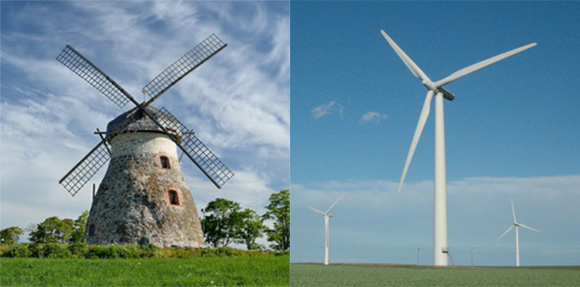Differences Between Wind Turbine and Windmill
Windmills and wind turbines are two of the most prominent technologies for harnessing wind energy and putting it into practice. Since the early days, sailors have used the wind to sail sailboats on rivers and lakes. Wind power technology has been transformed many times in human history and over time has become one of the leading mechanically based renewable energy sources. Wind turbines remain a reliable and cost-effective technology for generating electricity without even producing harmful gases. In this article, you can know the differences between wind turbine and windmill.

What is?
Windmills are one of the earliest and most efficient ways of man-made power generation. They harness wind energy and use it to perform functions such as pumping water, saw-milling timber, and grinding grain. They are carefully designed turbines that make the most of wind energy to generate electricity.
A wind turbine is a mechanical device that uses the kinetic energy of the wind to generate electricity, primarily for commercial applications. Wind turbine technology is one of the most cost-effective and reliable technologies for generating large amounts of electricity. It is a clean energy that utilizes wind energy without producing harmful gases.
The term windmill mainly refers to a wind powered machine that converts the energy of the wind into a water pump or grinds grains, such as wheat or corn, and turns them into flour to make bread. It harnesses wind energy directly and converts it into mechanical energy through blades called sails or blades. A wind turbine is a mechanical device that converts the kinetic energy of the wind into electricity without producing harmful gases. Wind turbine technology is one of the most efficient and low-cost renewable energy sources, utilizing wind power for power distribution.
Operating Principle:
Wind turbine blades work on the principle of lift and drag. They use the aerodynamic force created when the wind blows against the blades, which then move relative to the wind. In a windmill, when wind blows across the blades, different areas create pressure differences that cause the blades to rotate.
Wind turbines work on a simple principle. "T" usually consists of 2-3 large propeller-like blades that, when the wind blows, turn around a rotor, which is attached to the main shaft. When the wind blows, the blades of the turbine start to spin, which in turn drives the generator to generate electricity. Windmills contain huge blades that move in a circular motion when the wind hits them, which in turn rotates the shaft. The shaft then prompts a generator attached to the blades to generate electricity.
Application:
Windmills convert wind energy into rotational energy, mainly for pumping water. However, they are used commercially to generate electricity. They work efficiently in the harshest environmental conditions and extreme temperatures. From pumping water to crushing to crushing rock and agricultural materials, windmills have a wide range of applications. Wind turbines are used commercially to generate electricity for homes, schools or businesses.

